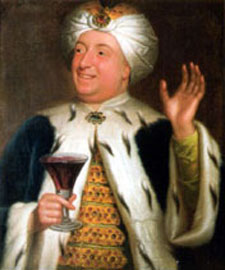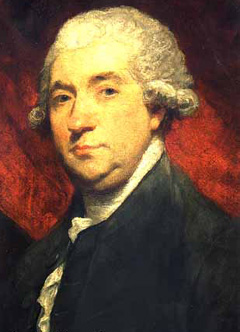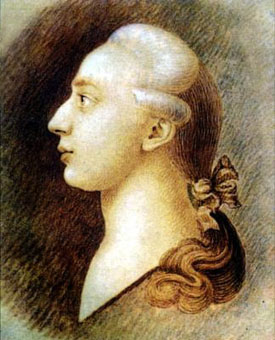
Envisioning Old St. Peter's Basilica
10 hours ago







 I've just finished reading Amanda Foreman's biog of the Duchess of Devonshire. I've got to tell you, I was somewhat disappointed. I know the book caused a sensation when it came out ten years ago, and I admire Foreman's scholarly take on the Duchess which avoids making nonsense assumptions that its subject was a proto-feminist, but a lot of the time I kept wondering if Georgiana was really worthy of a biography of such weight. Yes, she was an interesting woman, but she was constrained by her aristocratic position, which meant much of the book is taken up with trivialities: her ruinous gambling habit and the general bed-hopping of her set. This is why I've now turned to Norma Clarke's Queen of the Wits: A Life of Laetitia Pilkington because I'm more interested in figures on the fringes of Georgian society - people who had the freedom of movement than Georgiana did. I'll post more on that when I've finished it.
I've just finished reading Amanda Foreman's biog of the Duchess of Devonshire. I've got to tell you, I was somewhat disappointed. I know the book caused a sensation when it came out ten years ago, and I admire Foreman's scholarly take on the Duchess which avoids making nonsense assumptions that its subject was a proto-feminist, but a lot of the time I kept wondering if Georgiana was really worthy of a biography of such weight. Yes, she was an interesting woman, but she was constrained by her aristocratic position, which meant much of the book is taken up with trivialities: her ruinous gambling habit and the general bed-hopping of her set. This is why I've now turned to Norma Clarke's Queen of the Wits: A Life of Laetitia Pilkington because I'm more interested in figures on the fringes of Georgian society - people who had the freedom of movement than Georgiana did. I'll post more on that when I've finished it.



I should have mentioned last night that I met with a monstrous big whore in the Strand... I went into a tavern with her, where she displayed to me all the parts of her enormous carcass; but I found that her avarice was as large as her a---, for she would by no means take what I offered her... I was so much in the lewd humour that I felt myself restless, and took a little girl into a court; but wanted vigour. So I went home, resolved against low street debauchery.Much of this seems surprising when you consider Boswell's friendship with Johnson: a pious man who took a dim view of indulgences of any kind; in Boswell's Life of Johnson he records an exchange with the writer on the subject of prostitution, in which Johnson remarks: 'Sir, it is very absurd to argue, as has been often done, that prostitutes are necessary to prevent the violent effects of appetite from violating the decent order of life; nay, should be permitted, in order to preserve the chastity of our wives and daughters. Depend upon it, Sir, severe laws, steadily enforced, would be sufficient against those evils, and would promote marriage.'

A man with a large head, like a buffalo; dull; stupid; foolish.
From: Samuel Johnson's A Dictionary of the English Language: An Anthology


"At Madame ----'s, a literary lady of rank, the footman took the sugar in his fingers, and threw it into my coffee. I was going to put it aside; but hearing it was made on purpose for me, I e'en tasted Tom's fingers. The same lady would needs make tea à la Angloise. The spout of the tea-pot would not pour freely; she bade the footman blow into it. France is worse than Scotland in every thing but climate."Strong words when you consider how much Johnson complained about Scotland! Footmen were also viewed dubiously in Jonathan Swift's hilarious Directions to Servants: a kind of primer in which he addresses sardonic advice to each servant in the household. To the footman:
Take off the largest dishes and set them on with one hand, to show the ladies your vigour and strength of back, but always do it between two ladies, that if the dish happens to slip, the soup or sauce may fall on their clothes and not daub the floor... When you carry up a dish of meat, dip your fingers in the sauce, or lick it with your tongue to try whether it be good and fit for your master's table... If you are ordered to break the claw of a crab or lobster, clap it between the sides of the dining-room door between the hinges...Above is William Hogarth's wonderful Heads of Six of Hogarth's Servants (circa 1750-5).
 I’ve always been interested in the interplay of word and image, so one thing that I dearly hope to be catching over the Christmas period is Tate Liverpool’s show, William Blake - The River of Life (until Mar 29, 2009). Surprisingly, there’s virtually nothing about it on the website, apart from a press release, but the display apparently includes watercolour illustrations to Dante’s The Divine Comedy (above), plus some major paintings.
I’ve always been interested in the interplay of word and image, so one thing that I dearly hope to be catching over the Christmas period is Tate Liverpool’s show, William Blake - The River of Life (until Mar 29, 2009). Surprisingly, there’s virtually nothing about it on the website, apart from a press release, but the display apparently includes watercolour illustrations to Dante’s The Divine Comedy (above), plus some major paintings.
An ancient name for fifers; also persons at the universities who examine candidates for degrees. A whiffling cur, a small yelping cur.
From: Captain Grose's 1811 Dictionary of the Vulgar Tongue
 Due to an unpopular office move, I find myself having to wait for a shuttle bus in the freezing cold on a daily basis, but this morning I at least got some entertainment from Frances Wilson's article in the Literary Review on Lydia Syson's new book: Doctor of Love: James Graham and his Celestial Bed.
Due to an unpopular office move, I find myself having to wait for a shuttle bus in the freezing cold on a daily basis, but this morning I at least got some entertainment from Frances Wilson's article in the Literary Review on Lydia Syson's new book: Doctor of Love: James Graham and his Celestial Bed. Having a sift through The Georgian Group’s website, I was heartened to read about the Darnley Mausoleum in Kent – abandoned, then virtually destroyed when kids lit a bonfire inside it in 1980 – but now lovingly restored by Cobham Hall Estate, with funds from The Georgian Group and Union Railways.
Having a sift through The Georgian Group’s website, I was heartened to read about the Darnley Mausoleum in Kent – abandoned, then virtually destroyed when kids lit a bonfire inside it in 1980 – but now lovingly restored by Cobham Hall Estate, with funds from The Georgian Group and Union Railways. I felt a bit bad about my Handel in the nude posting, so to make it up to him, I'm giving a shout-out to the Messiah, and the intriguing news that Stephen Fry is supposed to be making a biopic about the composer.
I felt a bit bad about my Handel in the nude posting, so to make it up to him, I'm giving a shout-out to the Messiah, and the intriguing news that Stephen Fry is supposed to be making a biopic about the composer. Sir Francis Dashwood (1708-81)
Sir Francis Dashwood (1708-81) James Boswell (1740-1795)
James Boswell (1740-1795) Giacomo Casanova (1725-1798)
Giacomo Casanova (1725-1798) John Wilmot, 2nd Earl of Rochester (1647-1680)
John Wilmot, 2nd Earl of Rochester (1647-1680)
Ambitious Visca [mistletoe], from thy eagle-flight! - Scorning the sordid soil, aloft she springs, Shakes her white plume, and claps her golden wings; High o'er the fields of boundless ether roves, and seeks amid the clouds her soaring loves!
Footnote: Viscum. Mistletoe. This plant never grows upon the ground; the foliage is yellow, and the berries milk-white; the berries are so viscous, as to serve for bird-lime; and when they fall, adhere to the branches of the tree, on which the plant grows, and strike root into its bark; or are carried to distant trees by birds.

From The Chap Manifesto: Society has become sick with some nameless malady of the soul. We have become the playthings of corporations intent on converting our world into a gargantuan shopping precinct... we live in a world where children are huge hooded creatures lurking in the shadows; the local hostelry has been taken over by a large chain that specialises in chilled lager, whose principal function is to aggravate the nervous system... It is time for Chaps and Chapettes from all walks of life to stand up and be counted. But fear not, ye languid and ye plain idle: ours is a revolution based not on getting up early and exerting oneself - but a revolution that can be achieved by a single raised eyebrow over a monocle; the ordering of a glass of port in All Bar One; the wearing of a particularly fetching cardigan upon a visit to one's bookmaker...

Sacred to the Memory of The Right Honorable Lady MARY WORTLEY MONTAGUE, who happily introduced from Turkey into this country the Salutary Art of inoculating the Small-Pox. Convinc'd of its Efficacy she first tried it with Success On her own Children and then recommended the practice of it To her fellow-Citizens. Then by her Example and Advice we have soften'd the Virulence and escaped the danger of this malignant Disease. To perpetuate the Memory of such Benevolence, and express her Gratitude for the benefit she herself has receiv'd from the alleviating Art, this Monument is erected by HENRIETTA INGE relict of THEODORE WILLIAM INGE, Esq.r. and Daughter of Sir JOHN WROTTESLEY Baronet in the Year of OUR LORD MDCCLXXXIX

